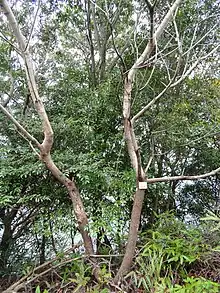Brucea javanica
Brucea javanica (also known as Macassar kernels)[3] is a shrub in the family Simaroubaceae. The specific epithet javanica is from the Latin, meaning "of Java".[4] Other common names in English include Java brucea and kosam.[5]
| Brucea javanica | |
|---|---|
 | |
| Scientific classification | |
| Kingdom: | Plantae |
| Clade: | Tracheophytes |
| Clade: | Angiosperms |
| Clade: | Eudicots |
| Clade: | Rosids |
| Order: | Sapindales |
| Family: | Simaroubaceae |
| Genus: | Brucea |
| Species: | B. javanica |
| Binomial name | |
| Brucea javanica | |
| Synonyms[1] | |
Description
Brucea javanica grows up as a shrub or small tree to 5 metres (20 ft) tall. The tiny flowers (1.5--2 mm in diameter) are greenish white to greenish red or purple and occur in panicles.[4] There are separate male and female flowers on each shrub, making it a monoecious species. The flower anthers are typically red.[3] It typically flowers in June and July and sets fruit in July and August.[6] Each fruit, which are a drupe, measures up to 0.5 cm (0.2 in) long.[4] When ripe they are a black-gray color that becomes wrinkled when dry. The seed is whitish yellow and covered with an oily membrane. It has compound leaves with typically 7--9 (but range from 3--15) ovate to ovate-lanceolate leaflets with serrate margins.[6] Each leaflet is 20–40 cm long at maturity and comes to a point at the apex. The leaves are covered with fine hairs that are most prominent at the veins and on the undersides of the leaves. All parts of the plant are intensely bitter.[6]
Distribution and habitat
Brucea javanica grows naturally from Sri Lanka and India to China, Indochina, Malesia, New Guinea and Australia.[2][4] Its habitat includes open areas, secondary forest and sometimes sand dunes.[4] In Australia it grows as an understory tree from sea-level to 500 metres (1,600 ft) altitude.[3]
Medicinal use
The fruit Brucea javanica was first written about as medicine in the Chinese medical monograph Omissions from the Grand Materia Medica, written in 1765.[7] It contains quassinoid compounds called bruceolides that are anticancer and antiparasitic.[8][9] It is traditionally used to treat dysentery and malaria, though no clinical trials have been published confirming efficacy for these conditions despite test tube studies repeatedly showing anti-malarial activity.[10][11] An injectable oil emulsion form of the plant has been studied in China in controlled trials for treating lung cancer patients combined with chemotherapy, with promising results.[12] More high-quality trials are needed to confirm this use.
References
- "Brucea javanica (L.) Merr". The Plant List. Retrieved 20 March 2015.
- "Brucea javanica". Germplasm Resources Information Network (GRIN). Agricultural Research Service (ARS), United States Department of Agriculture (USDA). Retrieved 20 March 2015.
- Hyland, B. P. M.; Whiffin, T.; Zich, F. A.; et al. (Dec 2010). "Factsheet – Brucea javanica". Australian Tropical Rainforest Plants (6.1, online version RFK 6.1 ed.). Cairns, Australia: Commonwealth Scientific and Industrial Research Organisation (CSIRO), through its Division of Plant Industry; the Centre for Australian National Biodiversity Research; the Australian Tropical Herbarium, James Cook University. Retrieved 20 March 2015.
- Kulip, Julius; Wong, K. M. (1995). "Brucea javanica (L.) Merr.". In Soepadmo, E.; Wong, K. M. (eds.). Tree Flora of Sabah and Sarawak. (free online from the publisher, lesser resolution scan PDF versions). 1. Forest Research Institute Malaysia. pp. 429, 431. ISBN 983-9592-34-3. Archived from the original (PDF) on 27 September 2013. Retrieved 20 March 2015.
- Quattrocchi, Umberto (1999). CRC World Dictionary of Plant Names: Common Names, Scientific Names, Eponyms, Synonyms, and Etymology. 1. CRC Press. p. 362. ISBN 978-0-849326-73-8.
- "Brucea javanica (Linnaeus) Merrill, J. Arnold Arbor. 9: 3. 1928". Flora of China. Missouri Botanical Garden. Retrieved 20 September 2016.
- Bensky, Dan; Clavey, Steven; Stöger, Erich; Gamble, Andrew (2004). Chinese Herbal Medicine Materia Medica (3rd ed.). Eastland Press. ISBN 0-939616-42-4.
- Roberts, MF (1994). Bajaj, YPS (ed.). Biotechnology in Agriculture and Forestry: Medicinal and Aromatic Plants VI. 26. Springer Verlag. pp. 21–45.
- Chen, MW; Chen, R; Wang, SP; Tan, W; et al. (2013). "Chemical components, pharmacological properties, and nanoparticulate delivery systems of Brucea javanica". Int J Nanomed. 8: 85–92. doi:10.2147/IJN.S31636. PMC 3540955. PMID 23319860.
- WHO Monographs on Selected Medicinal Plants. 1. World Health Organization. 1999.
- Kefe, A; Giday, M; Mamo, H; Erko, B (2016). "Antimalarial properties of crude extracts of seeds of Brucea antidysenterica and leaves of Ocimum lamiifolium". BMC Complement Altern Med. 16: 118. doi:10.1186/s12906-016-1098-9. PMC 4831165. PMID 27075995.
- Nie, YL; Liu, KX; Mao, XY; Li, YL; Li, J; Zhang, MMdate=2012 (2012). "Effect of injection of brucea javanica oil emulsion plus chemoradiotherapy for lung cancer: a review of clinical evidence". J Evid Based Med. 5 (4): 216–225. doi:10.1111/jebm.12001. PMID 23557502.